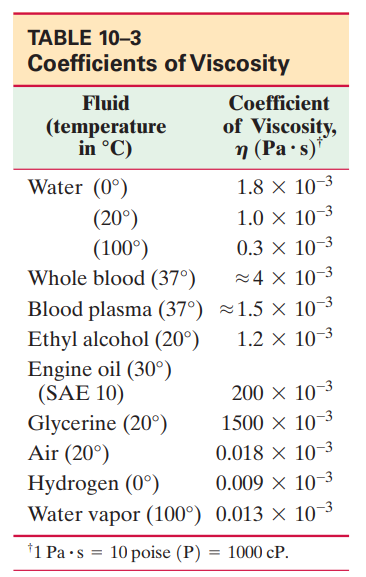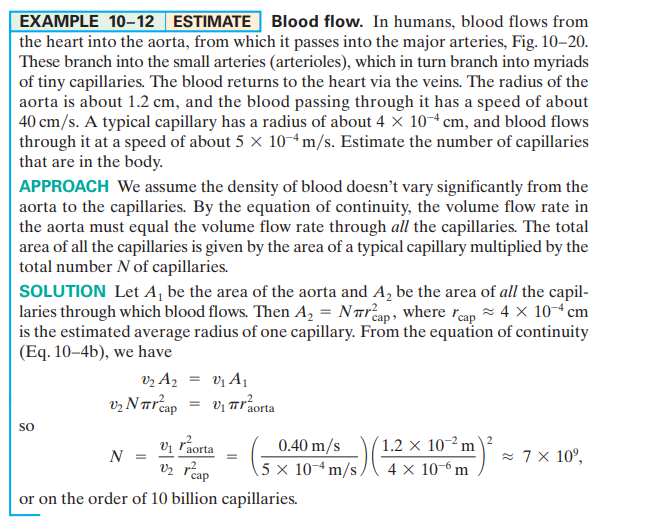TABLE 10–3 Coefficients of Viscosity Fluid Coefficient (temperature in °C) of Viscosity, n (Pa·s) Water (0°) 1.8 × 10-3 (20°) (100°) Whole blood (37°) 1.0 × 10-3 0.3 × 10-3 24 × 10-3 Blood plasma (37°) ~1.5 × 10-3 Ethyl alcohol (20°) Engine oil (30°) (SAE 10) Glycerine (20°) Air (20°) Hydrogen (0°) 1.2 × 10-3 200 × 10-3 1500 × 10-3 0.018 × 10¬3 0.009 × 10-3 Water vapor (100°) 0.013 × 10¬3 t1 Pa •s 10 poise (P) = 1000 cP. EXAMPLE 10–12 ESTIMATE Blood flow. In humans, blood flows from the heart into the aorta, from which it passes into the major arteries, Fig. 10–20. |These branch into the small arteries (arterioles), which in turn branch into myriads of tiny capillaries. The blood returns to the heart via the veins. The radius of the aorta is about 1.2 cm, and the blood passing through it has a speed of about 40 cm/s. A typical capillary has a radius of about 4 x 104 cm, and blood flows through it at a speed of about 5 x 10-m/s. Estimate the number of capillaries that are in the body. APPROACH We assume the density of blood doesn't vary significantly from the aorta to the capillaries. By the equation of continuity, the volume flow rate in the aorta must equal the volume flow rate through all the capillaries. The total area of all the capillaries is given by the area of a typical capillary multiplied by the total number N of capillaries. SOLUTION Let A, be the area of the aorta and A, be the area of all the capil- laries through which blood flows. Then A, = Nurap, where rap = 4 x 104 cm is the estimated average radius of one capillary. From the equation of continuity (Eq. 10-4b), we have v2 A2 vz N rreap Vị A1 Vị Tráorta SO 1.2 × 10-²m 4 x 10-6 m 2 0.40 m/s 5 × 10-4 m/s. Vị raorta 2 7 × 10°, N v2 réap or on the order of 10 billion capillaries.
Fluid Pressure
The term fluid pressure is coined as, the measurement of the force per unit area of a given surface of a closed container. It is a branch of physics that helps to study the properties of fluid under various conditions of force.
Gauge Pressure
Pressure is the physical force acting per unit area on a body; the applied force is perpendicular to the surface of the object per unit area. The air around us at sea level exerts a pressure (atmospheric pressure) of about 14.7 psi but this doesn’t seem to bother anyone as the bodily fluids are constantly pushing outwards with the same force but if one swims down into the ocean a few feet below the surface one can notice the difference, there is increased pressure on the eardrum, this is due to an increase in hydrostatic pressure.
(II) Calculate the pressure drop per cm along the aorta
using the data of Example 10–12 and Table 10–3.


Trending now
This is a popular solution!
Step by step
Solved in 3 steps with 4 images









